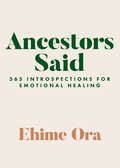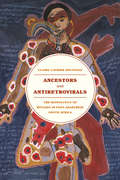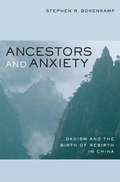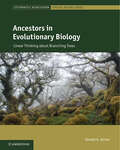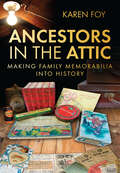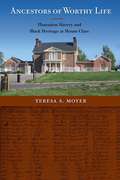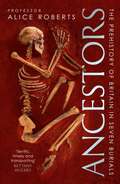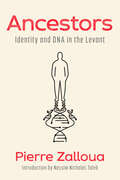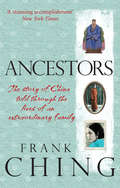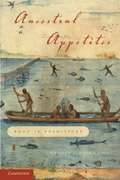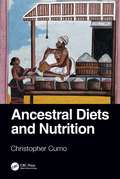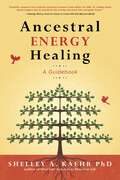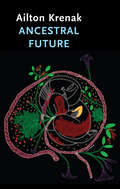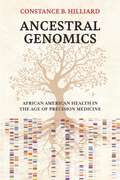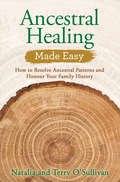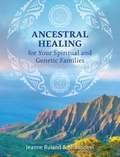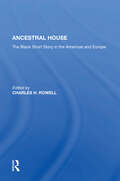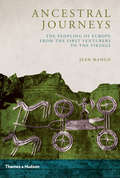- Table View
- List View
Ancestors Said: 365 Introspections for Emotional Healing
by Ehime OraA joy-filled gift from the ancestors composed of 365 gentle prayers and affirmations to intuitively provide you with healing all year long.&“Ancestors said they experience life through your eyes. Living your life as full as you can nourishes them. You being alive is enough for them.&” &“I pray that you see life through. I pray that you let it show you just how good it can get.&” &“If you&’re feeling stuck, speak to the heavens. A path to freedom will open up.&”Ancestors Said is full of 365 affirmations, prayers, and reflections just like these. It is designed to be used all year long, helping the reader along a healing journey and leading them to experience a deep connection with the ancestors and joy in their daily life.
Ancestors and Antiretrovirals: The Biopolitics of HIV/AIDS in Post-Apartheid South Africa
by Claire Laurier DecoteauIn the years since the end of apartheid, South Africans have enjoyed a progressive constitution, considerable access to social services for the poor and sick, and a booming economy that has made their nation into one of the wealthiest on the continent. At the same time, South Africa experiences extremely unequal income distribution, and its citizens suffer the highest prevalence of HIV in the world. As Archbishop Desmond Tutu has noted, AIDS is South Africa s new apartheid. In "Ancestors and Antiretrovirals," Claire Laurier Decoteau backs up Tutu s assertion with powerful arguments about how this came to pass. Decoteau traces the historical shifts in health policy after apartheid and describes their effects, detailing, in particular, the changing relationship between biomedical and indigenous health care, both at the national and the local level. Decoteau tells this story from the perspective of those living with and dying from AIDS in Johannesburg s squatter camps. At the same time, she exposes the complex and often contradictory ways that the South African government has failed to balance the demands of neoliberal capital with the considerable health needs of its population. "
Ancestors and Antiretrovirals: The Biopolitics of HIV/AIDS in Post-Apartheid South Africa
by Claire Laurier DecoteauIn the years since the end of apartheid, South Africans have enjoyed a progressive constitution, considerable access to social services for the poor and sick, and a booming economy that has made their nation into one of the wealthiest on the continent. At the same time, South Africa experiences extremely unequal income distribution, and its citizens suffer the highest prevalence of HIV in the world. As Archbishop Desmond Tutu has noted, “AIDS is South Africa’s new apartheid.” In Ancestors and Antiretrovirals, Claire Laurier Decoteau backs up Tutu’s assertion with powerful arguments about how this came to pass. Decoteau traces the historical shifts in health policy after apartheid and describes their effects, detailing, in particular, the changing relationship between biomedical and indigenous health care, both at the national and the local level. Decoteau tells this story from the perspective of those living with and dying from AIDS in Johannesburg’s squatter camps. At the same time, she exposes the complex and often contradictory ways that the South African government has failed to balance the demands of neoliberal capital with the considerable health needs of its population.
Ancestors and Anxiety: Daoism and the Birth of Rebirth in China
by Stephen R. BokenkampThis innovative work on Chinese concepts of the afterlife is the result of Stephen Bokenkamp's groundbreaking study of Chinese scripture and the incorporation of Indic concepts into the Chinese worldview. Here, he explores how Chinese authors, including Daoists and non-Buddhists, received and deployed ideas about rebirth from the third to the sixth centuries C.E.
Ancestors in Evolutionary Biology: Linear Thinking about Branching Trees (Systematics Association Special Volume Series)
by Ronald A. JennerPhylogenetics emerged in the second half of the nineteenth century as a speculative storytelling discipline dedicated to providing narrative explanations for the evolution of taxa and their traits. It coincided with lineage thinking, a process that mentally traces character evolution along lineages of hypothetical ancestors. Ancestors in Evolutionary Biology traces the history of narrative phylogenetics and lineage thinking to the present day, drawing on perspectives from the history of science, philosophy of science, and contemporary scientific debates. It shows how the power of phylogenetic hypotheses to explain evolution resides in the precursor traits of hypothetical ancestors. This book provides a comprehensive exploration of the topic of ancestors, which is central to modern biology, and is therefore of interest to graduate students, researchers, and academics in evolutionary biology, palaeontology, philosophy of science, and the history of science.
Ancestors in the Attic: Making Family Memorabilia into History
by Karen FoyMuch family history focuses on digging around archives and web searches. Here, Karen Foy shows that our attics and cupboards can often hide a treasure trove of personal documents and ephemera. Boxes full of photographs, hastily written notes, old tickets, postcards, ration books, a soldier’s hat, a bundle of letters, perhaps a diary, are all invaluable sources of information about our family history. These are crucial in piecing together the everyday lives of our ancestors, exposing secrets, and family relationships. You might discover favourite family recipes, information about their schooldays, reconstruct a Victorian family holiday. This book guides you through 200 years of different types of memorabilia: how to interpret them and how to use them to make your own family history – perhaps making a scrapbook or website.
Ancestors of Worthy Life: Plantation Slavery and Black Heritage at Mount Clare (Cultural Heritage Studies)
by Teresa S. MoyerRecognizing the lives of the enslaved at the historic site of Mount ClareEnslaved African Americans helped transform the United States economy, culture, and history. Yet these individuals' identities, activities, and sometimes their very existence are often all but expunged from historically preserved plantations and house museums. Reluctant to show and interpret the homes and lives of the enslaved, many sites have never shared the stories of the African Americans who once lived and worked on their land. One such site is Mount Clare near Baltimore, Maryland, where Teresa Moyer pulls no punches in her critique of racism in historic preservation.In her balanced discussion, Moyer examines the inextricably entangled lives of the enslaved, free Black people, and white landowners. Her work draws on evidence from archaeology, history, geology, and other fields to explore the ways that white privilege continues to obscure the contributions of Black people at Mount Clare. She demonstrates that a landscape's post-emancipation history can make a powerful statement about Black heritage. Ultimately she argues that the inclusion of enslaved persons in the history of these sites would honor these "ancestors of worthy life," make the social good of public history available to African Americans, and address systemic racism in America.Publication of the paperback edition made possible by a Sustaining the Humanities through the American Rescue Plan grant from the National Endowment for the Humanities.
Ancestors, Territoriality, and Gods: A Natural History of Religion (The Frontiers Collection)
by Ina Wunn Davina GrojnowskiThis books sets out to explain how and why religion came into being. Today this question is as fascinating as ever, especially since religion has moved to the centre of socio-political relationships. In contrast to the current, but incomplete approaches from disciplines such as cognitive science and psychology, the present authors adopt a new approach, equally manifest and constructive, that explains the origins of religion based strictly on behavioural biology. They employ accepted research results that remove all need for speculation. Decisive factors for the earliest demonstrations of religion are thus territorial behaviour and ranking, coping with existential fears, and conflict solution with the help of rituals. These in turn, in a process of cultural evolution, are shown to be the roots of the historical and contemporary religions.
Ancestors: A Family History
by William MaxwellThe National Book Award-winning author of So Long, See You Tomorrow offers an astonishing evocation of a vanished world, as he retraces, branch by branch, the history of his family, taking readers into the lives of settlers, itinerant preachers, and small businessmen, examining the way they saw their world and how they imagined the world to come.
Ancestors: A prehistory of Britain in seven burials
by Alice RobertsAn extraordinary exploration of the ancestry of Britain through seven burial sites. By using new advances in genetics and taking us through important archaeological discoveries, Professor Alice Roberts helps us better understand life today.&‘This is a terrific, timely and transporting book - taking us heart, body and mind beyond history, to the fascinating truth of the prehistoric past and the present&’ Bettany Hughes We often think of Britain springing from nowhere with the arrival of the Romans. But in Ancestors, pre-eminent archaeologist, broadcaster and academic Professor Alice Roberts explores what we can learn about the very earliest Britons, from burial sites and by using new technology to analyse ancient DNA. Told through seven fascinating burial sites, this groundbreaking prehistory of Britain teaches us more about ourselves and our history: how people came and went and how we came to be on this island. It explores forgotten journeys and memories of migrations long ago, written into genes and preserved in the ground for thousands of years. This is a book about belonging: about walking in ancient places, in the footsteps of the ancestors. It explores our interconnected global ancestry, and the human experience that binds us all together. It&’s about reaching back in time, to find ourselves, and our place in the world.PRE-ORDER CRYPT, THE FINAL BOOK IN ALICE ROBERTS' BRILLIANT TRILOGY – OUT FEBRUARY 2024.
Ancestors: Identity and DNA in the Levant
by Pierre ZallouaAn eye-opening investigation into ancestry and origins in the Middle East that synthesizes thousands of years of genetic history in the region to question what it means to be indigenous to any land&“Ancestors transcends geography to launch an eye-opening inquiry into the relationship of genetics and identity. It&’s a transformational read for us all.&”—Jason Roberts, author of Every Living Thing and A Sense of the WorldIn recent years, genetic testing has become easily available to consumers across the globe, making it relatively simple to find out where your ancestors came from. But what do these test results actually tell us about ourselves?In Ancestors, Pierre Zalloua, a leading authority on population genetics, argues that these test results have led to a dangerous oversimplification of what one&’s genetic heritage means. Genetic ancestry has become conflated with anthropological categories such as &“origin,&” &“ethnicity,&” and even &“race&” in spite of the complexities that underlie these concepts. And nowhere is this interplay more important and more controversial, Zalloua writes, than in the Levant—an ancient region known as one of the cradles of civilization and that now includes Palestine, Israel, Jordan, Lebanon, Syria, and parts of Turkey.Born in Lebanon, Zalloua grew up surrounded by people for whom the question of identity was a matter of life or death. Building on years of research, he tells a rich and compelling history of the Levant through the framework of genetics that spans from one hundred thousand years ago, when humans first left Africa, to the twenty-first century and modern nation-states.A timely, paradigm-shifting investigation into ancestry and origins in the Middle East, Ancestors ultimately reframes what it means to be indigenous to any land—urging us to reshape how we think about home, belonging, and where culture really comes from.
Ancestors: The story of China told through the lives of an extraordinary family
by Frank ChingFrank Ching brings to life 900 years of Chinese history through his own fascinating family tree. Beginning with his search for the grave of his first recorded ancestor, the 11th century poet Qin Guan, and ending with a moving account of his relationship with his father, a victim of China's historic upheaval, Frank Ching introduces a colourful cast of characters. His unbroken family line includes - among many others - a lovelorn concubine, a traitor, a military hero, an imperial ghost-writer, a minister of punishments and a woman noted for her skills in both verse and martial arts. There is scarcely an aspect of Chinese life, from shamanism to violent rebellion, that Ching doesn't touch upon in this fascinating work. Through his vivid and personal portraits of his ancestors the history of China itself unfolds: from the days of the ancient empire to its radical transformation today.
Ancestral Appetites: Food in Prehistory
by Kristen J. GremillionThis book explores the relationship between prehistoric people and their food - what they ate, why they ate it and how researchers have pieced together the story of past foodways from material traces. Contemporary human food traditions encompass a seemingly infinite variety, but all are essentially strategies for meeting basic nutritional needs developed over millions of years. Humans are designed by evolution to adjust our feeding behaviour and food technology to meet the demands of a wide range of environments through a combination of social and experiential learning. In this book, Kristen J. Gremillion demonstrates how these evolutionary processes have shaped the diversification of human diet over several million years of prehistory. She draws on evidence extracted from the material remains that provide the only direct evidence of how people procured, prepared, presented and consumed food in prehistoric times.
Ancestral Diets and Nutrition
by Christopher CumoAncestral Diets and Nutrition supplies dietary advice based on the study of prehuman and human populations worldwide over the last two million years. This thorough, accessible book uses prehistory and history as a laboratory for testing the health effects of various foods. It examines all food groups by drawing evidence from skeletons and their teeth, middens, and coprolites along with written records where they exist to determine peoples&’ health and diet. Fully illustrated and grounded in extensive research, this book enhances knowledge about diet, nutrition, and health. It appeals to practitioners in medicine, nutrition, anthropology, biology, chemistry, economics, and history, and those seeking a clear explanation of what humans have eaten across the ages and what we should eat now. Features: Sixteen chapters examine fat, sweeteners, grains, roots and tubers, fruits, vegetables, and animal and plant sources of protein. Integrates information about diet, nutrition, and health from ancient, medieval, modern and current sources, drawing from the natural sciences, social sciences, and humanities. Provides comprehensive coverage based on the study of several hundred sources and the provision of over 2,000 footnotes. Presents practical information to help shape readers&’ next meal through recommendations of what to eat and what to avoid.
Ancestral Encounters in Highland Madagascar
by Zoë CrosslandNineteenth-century highland Madagascar was a place inhabited by the dead as much as the living. Ghosts, ancestors and the possessed were important historical actors alongside local kings and queens, soldiers, traders and missionaries. This book considers the challenges that such actors pose for historical accounts of the past and for thinking about questions of presence and representation. How were the dead made present, and how were they recognized or not? In attending to these multifarious encounters of the nineteenth century, how might we reflect on the ways in which our own history-writing makes the dead present? To tackle these questions, Zoë Crossland tells an anthropological history of highland Madagascar from a perspective rooted in archaeology and Peircean semiotics, as well as in landscape study, oral history and textual sources.
Ancestral Energy Healing: A Guidebook
by Shelley A. KaehrHeal Inherited Family Trauma with All-New TechniquesExpanding upon Shelley A. Kaehr's award-winning international bestseller Heal Your Ancestors to Heal Your Life, this book features hands-on workings from her revolutionary Ancestral Healing and Genealogical Regression practice.In addition to examples from her case studies, Shelley presents nearly fifty exercises and nearly fifty journal prompts designed to help you connect with immediate family lineages and repair troubled relationships. Discover the profound healing potential of rituals, meditations, trance work, and other practices as you overcome challenging chapters in your genetic heritage.These exercises help you meet your spirit guides, embrace your soul gifts, and reimagine difficult ancestral events by creating a new experience and narrative. Shelley also teaches you how to send love and support to future generations and receive your ancestors’ wisdom so you can make better decisions in the present. Includes a foreword by Cyndi Dale, bestselling author of Energy Work for the Everyday to Elite Athlete
Ancestral Fault in Ancient Greece
by Renaud GagnéAncestral fault is a core idea of Greek literature. 'The guiltless will pay for the deeds later: either the man's children, or his descendants thereafter', said Solon in the sixth century BC, a statement echoed throughout the rest of antiquity. This notion lies at the heart of ancient Greek thinking on theodicy, inheritance and privilege, the meaning of suffering, the links between wealth and morality, individual responsibility, the bonds that unite generations and the grand movements of history. From Homer to Proclus, it played a major role in some of the most critical and pressing reflections of Greek culture on divinity, society and knowledge. The burning modern preoccupation with collective responsibility across generations has a long, deep antecedent in classical Greek literature and its reception. This book retraces the trajectories of Greek ancestral fault and the varieties of its expression through the many genres and centuries where it is found.
Ancestral Future (Critical South)
by Ailton KrenakIn response to the damage caused by centuries of colonial ravaging and the current ecological, political and social crises, the leading Indigenous thinker and activist Ailton Krenak warns against the power of corporate capitalism and its destructive impact. Capitalism encroaches on every corner of the planet and orients us toward a future of promised progress, achievement and growth, but this future doesn’t exist – we just imagine it. This orientation to the future also blinds us to what exists around us, to the plants and animals with which we share the Earth and to the rivers that flow through our lands. Rivers are not just resources to be exploited by us or channels to carry away our waste, they are beings that connect us with our past. If there is a future to imagine, it is ancestral, since it is already present in the here and now and in that which exists around us, in the rivers and mountains and trees that are our kin. In a spoken language that has the mark of ancestral oral wisdom, Krenak offers a new perspective that challenges and disrupts some of the assumptions that underpin Western attitudes and mentalities. His work will be of great interest to anyone concerned about the climate crisis and the worsening plight of our planet.
Ancestral Genealogies in Modern China: A Study of Lineage Organizations in Hong Kong and Mainland China (Routledge Culture, Society, Business in East Asia Series)
by Masahisa SegawaThis book explores the remarkable phenomenon of Chinese lineages – groups of people connected through patrilineal kinship ties, which have existed for centuries in China and which are currently undergoing significant revival after being suppressed in many parts of China during the cultural revolution period. The book considers how lineages and the associated networks and membership associations have developed, surveys how lineages have been studied by anthropologists and others over time in different ways, and discusses the important social functions of lineages in contemporary Hong Kong and mainland China.
Ancestral Genomics: African American Health in the Age of Precision Medicine
by Constance B. HilliardA leading evolutionary historian offers a radical solution to racial health disparities in the United States.Constance B. Hilliard was living in Japan when she began experiencing joint pain. Her doctor diagnosed osteoarthritis—a common ailment for someone her age. But her bloodwork showed something else: Hilliard, who had never had kidney problems, appeared to be suffering from renal failure. When she returned to Texas, however, a new round of tests showed that her kidneys were healthy. Unlike the Japanese doctor, her American primary care provider had checked a box on her lab report for “African American.” As a scholar of scientific racism, Hilliard was perplexed. Why should race, which experts agree has no biological basis, matter for getting accurate test results?Ancestral Genomics is the result of Hilliard’s decade-long quest to solve this puzzle. In a masterful synthesis of evolutionary history, population genetics, and public health research, she addresses the usefulness of race as a heuristic in genomic medicine. Built from European genetic data, the Human Genome Project and other databases have proven inadequate for identifying disease-causing gene variants in patients of African descent. Such databases, Hilliard argues, overlook crucial information about the environments to which their ancestors’ bodies adapted prior to the transatlantic slave trade. Hilliard shows how, by analyzing “ecological niche populations,” a classification model that combines family and ecological histories with genetic information, our increasingly advanced genomic technologies, including personalized medicine, can serve African Americans and other people of color, while avoiding racial essentialism.Forcefully argued and morally urgent, Ancestral Genomics is a clarion call for the US medical community to embrace our multigenomic society.
Ancestral Geographies of the Neolithic: Landscapes, Monuments and Memory
by Mark EdmondsArchaeological evidence suggests that Neolithic sites had many different, frequently contradictory functions, and there may have been other uses for which no evidence survives. How can archaeologists present an effective interpetation, with the consciousness that both their own subjectivity, and the variety of conflicting views will determine their approach. Because these sites have become a focus for so much controversy, the problem of presenting them to the public assumes a critical importance. The authors do not seek to provide a comprehensive review of the archaeology of all these causewayed sites in Britain; rather they use them as case studies in the development of an archaeological interpetation.
Ancestral Healing Made Easy: How to Resolve Ancestral Patterns and Honour Your Family History
by Natalia O'Sullivan Terry O'SullivanIdentify old family wounds, communicate with your ancestral guides, heal your lineage and achieve wellbeing for yourself and loved ones.To understand who we are, we must know where and who we come from. Discover powerful practices to honour and heal your family lineage.Ancestral healing is the process of revealing and releasing inherited wounds and traumas that have been passed down by our ancestors. Anyone researching their heritage will uncover both positive and negative issues that pass through the bloodlines from one generation to the next. Once we understand the effects our family has had on our wellbeing, we can find ways to heal their influences and celebrate their legacy.Renowned soul rescuers Natalia and Terry O'Sullivan have distilled an array of practices, rituals, exercises and meditations to help you: • explore what ancestral healing is and how it can aid you • recognize how unresolved ancestral wounds have impacted your life • learn how to use rituals and practical exercises to honour and communicate with your ancestors • balance your physical, emotional and psychological wellbeing through healing the family woundsThe journey of ancestral healing is one of evolution and restoration. Each step, ritual and prayer will take you closer to the life your ancestors have dreamed for you.
Ancestral Healing for Your Spiritual and Genetic Families
by Jeanne Ruland ShantideviA practical guide to shamanic ancestor work, inspired by Huna and supported by guided rituals and exercises • Explains how to heal traumatic experiences and old blockages that are stored in the memory of your lineage • Includes Hawaiian teachings about spiritual and genetic ancestors and reveals how to bond with your spirit family, your Aumakua • Shows how unlocking the support of your ancestors enables you to shine your light fully Knowing your ancestral lineage is not only a matter of curiosity, your life path will unfold with much more ease if you are aware and in harmony with your origins. Exploring the heritage of your bloodline as well as the energy of your spiritual family, which we are often less aware of, opens you up to enormous potential for healing and self-development. This practical guide explains, in a clear and straightforward way, how the energy field of our ancestors influences our personal lives and how we can draw from their strength as well as liberate ourselves from burdens that have been carried over generations. It helps us to lift the veil of forgetting and allow ourselves to fully shine our light, supported by the souls that came before us, by making peace with past hurts and traumas. Drawing on the Huna Hawaiian shamanic tradition as well as other shamanic and energetic practices, the authors show how to connect with our Aumakua, our ancestors and higher self, which includes our close relatives, ancestors stretching back thousands of years, and our spiritual ancestors or karmic family. The authors offer practices to reconcile with our parents and spiritual family, uncover suppressed matters and family secrets, clear and charge our personal energy field and our family energy field, and awaken the potential of our bloodline. They explain how to perform an ancestor healing circle, carry out an ancestor release ritual, and offer blessings for children and grandchildren as well as providing meditative journeys to meet our ancestors, our spiritual family, and our spiritual roots in other realms. They also provide short case studies to illustrate how the rituals and exercises have worked for other people. By enacting ancestral healing, we can recognize who we are, where we come from, and truly fulfill our destiny in this life.
Ancestral House: The Black Short Story In The Americas And Europe
by Charles RowellAn anthology of 70 short stories by writers of African descent. The authors are from Europe and the Americas (about half of them from the United States), and they include Alice Walker, Hal Bennett and John Edgar Wideman.
Ancestral Journeys: The Peopling of Europe from the First Venturers to the Vikings
by Jean MancoIncorporates the latest discoveries and theories from archaeology, genetics, history, and linguistics to paint a spirited history of European settlement Who are the Europeans and where did they come from? In recent years scientific advances have released a mass of data, turning cherished ideas upside down. The idea of migration in prehistory, so long out of favor, is back on the agenda. New advances allow us to track human movement and the spread of crops, animals, and disease, and we can see the evidence of population crashes and rises, both continent-wide and locally. Visions of continuity have been replaced with a more dynamic view of Europe's past, with one wave of migration followed by another, from the first human arrivals in Europe to the Vikings. Ancient DNA links Europe to its nearest neighbors. It is not a new idea that farming was brought from the Near East, but genetics now reveal an unexpectedly complex process in which farmers arrived not in one wave, but several. Even more unexpected is the evidence that the European gene pool was stirred vigorously many times after farming had reached most of Europe. Climate change played a part in this upheaval, but so did new inventions such as the c and wheeled vehicles. Genetic and linguistic clues also enhance our understanding of the upheavals of the Migration Period, the wanderings of steppe nomads, and the adventures of the Vikings.
